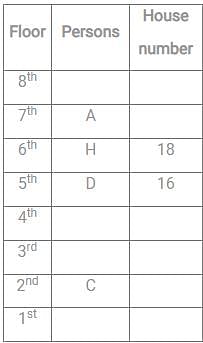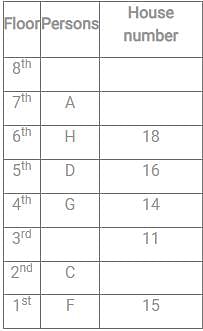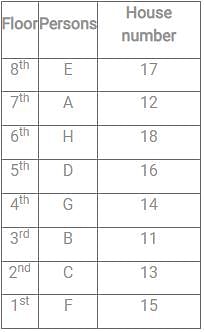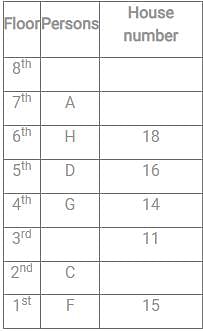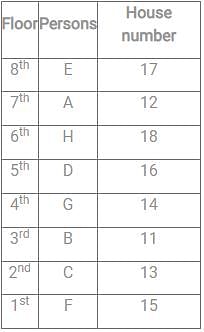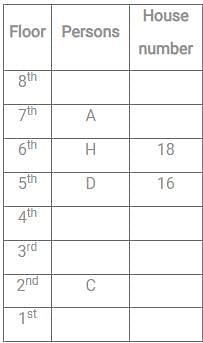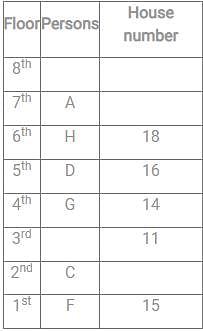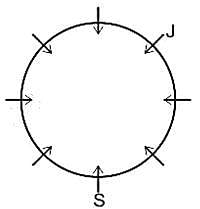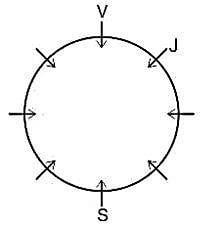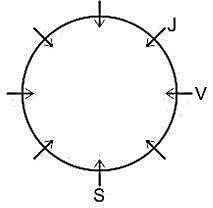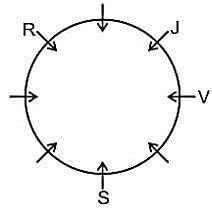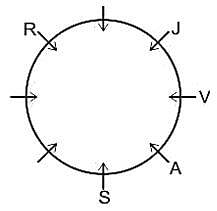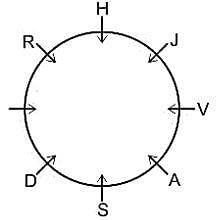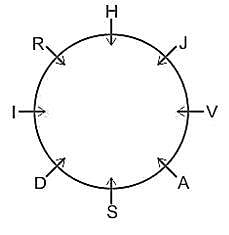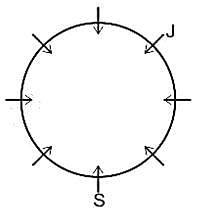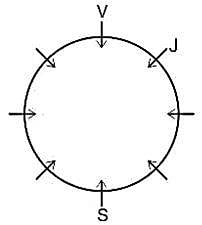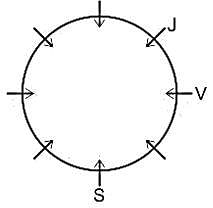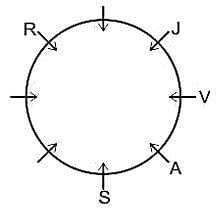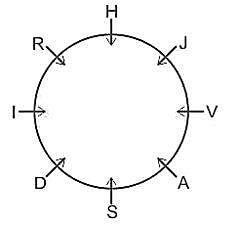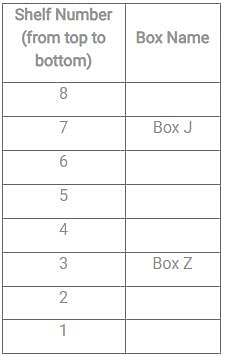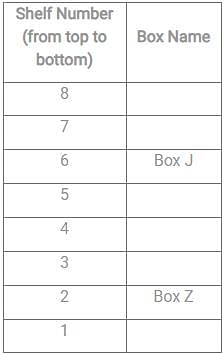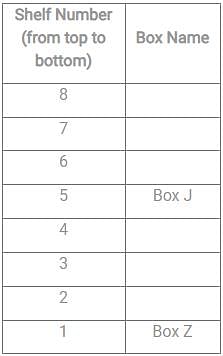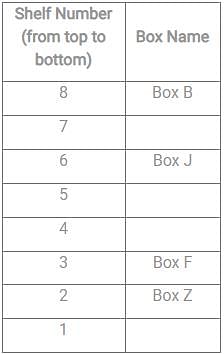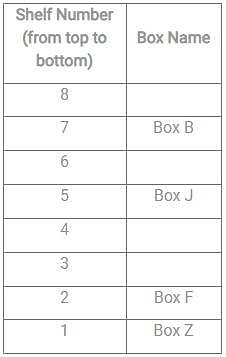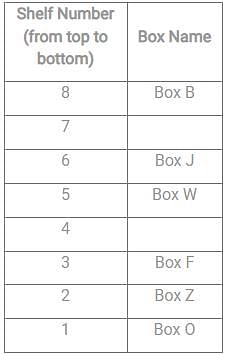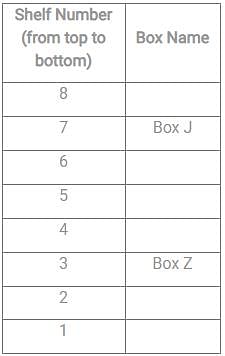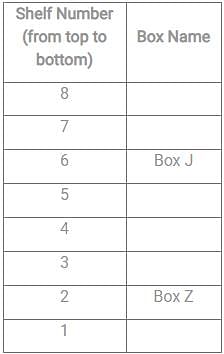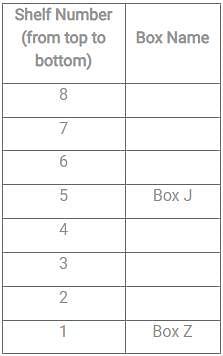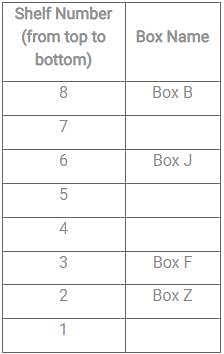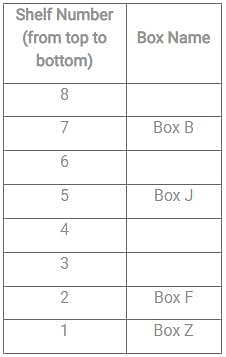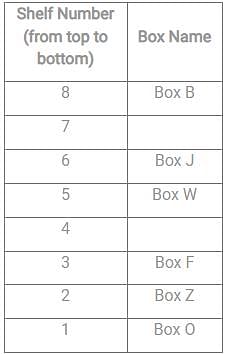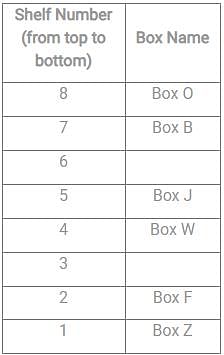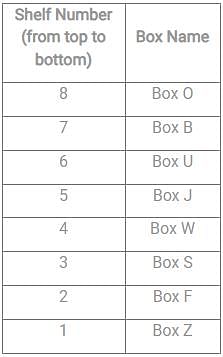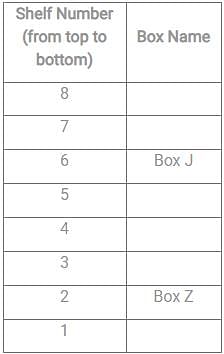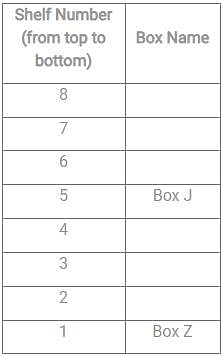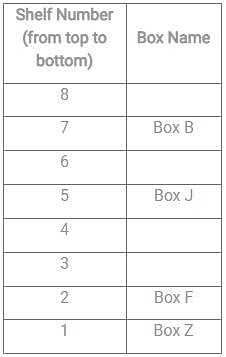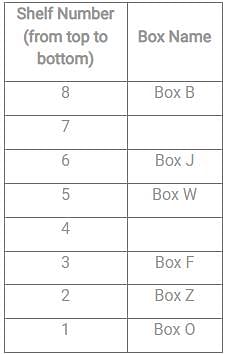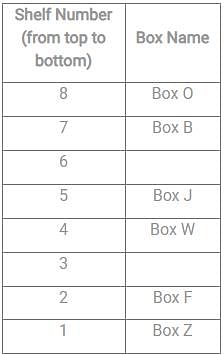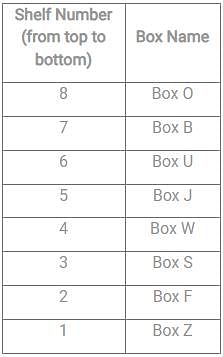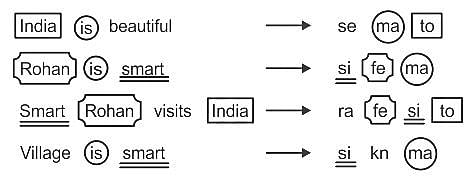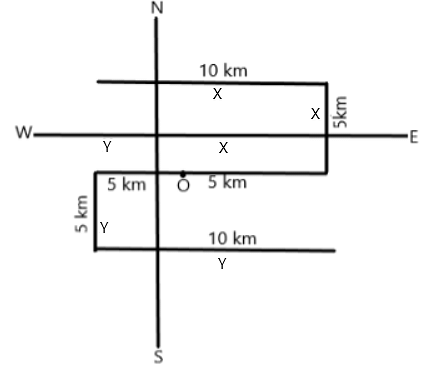ECGC PO Mock Test - 3 - Bank Exams MCQ
30 Questions MCQ Test - ECGC PO Mock Test - 3
Direction: Read the following information carefully and answer the questions that follow:
There are eight people, A, B, C, D, E, F, G and H who live on different floors of a building. The ground floor of the building is numbered 1, the floor above it is 2 until the topmost floor is numbered 8. Their house numbers vary from 11 to 18, but not necessarily in the same order.
F’s house number is 15 and doesn’t live on 4th or 8th floor. G doesn’t live on the top floor and his house number is 14. H lives on the 6th floor and his house number is 18. A person whose house number is 11 lives on the 3rd floor. B’s floor is immediately above the person whose house number is 13. C and A live on 2nd and 7th floors respectively. A person whose house number is 12 lives immediately below the person whose house number is 17. D lives on the 5th floor and his house number is 16.
Q. Which of the following statements is incorrect?
There are eight people, A, B, C, D, E, F, G and H who live on different floors of a building. The ground floor of the building is numbered 1, the floor above it is 2 until the topmost floor is numbered 8. Their house numbers vary from 11 to 18, but not necessarily in the same order.
F’s house number is 15 and doesn’t live on 4th or 8th floor. G doesn’t live on the top floor and his house number is 14. H lives on the 6th floor and his house number is 18. A person whose house number is 11 lives on the 3rd floor. B’s floor is immediately above the person whose house number is 13. C and A live on 2nd and 7th floors respectively. A person whose house number is 12 lives immediately below the person whose house number is 17. D lives on the 5th floor and his house number is 16.
Direction: Read the following information carefully and answer the questions that follow:
There are eight people, A, B, C, D, E, F, G and H who live on different floors of a building. The ground floor of the building is numbered 1, the floor above it is 2 until the topmost floor is numbered 8. Their house numbers vary from 11 to 18, but not necessarily in the same order.
F’s house number is 15 and doesn’t live on 4th or 8th floor. G doesn’t live on the top floor and his house number is 14. H lives on the 6th floor and his house number is 18. A person whose house number is 11 lives on the 3rd floor. B’s floor is immediately above the person whose house number is 13. C and A live on 2nd and 7th floors respectively. A person whose house number is 12 lives immediately below the person whose house number is 17. D lives on the 5th floor and his house number is 16.
Q. Which among the following is the correct pair?
There are eight people, A, B, C, D, E, F, G and H who live on different floors of a building. The ground floor of the building is numbered 1, the floor above it is 2 until the topmost floor is numbered 8. Their house numbers vary from 11 to 18, but not necessarily in the same order.
F’s house number is 15 and doesn’t live on 4th or 8th floor. G doesn’t live on the top floor and his house number is 14. H lives on the 6th floor and his house number is 18. A person whose house number is 11 lives on the 3rd floor. B’s floor is immediately above the person whose house number is 13. C and A live on 2nd and 7th floors respectively. A person whose house number is 12 lives immediately below the person whose house number is 17. D lives on the 5th floor and his house number is 16.
| 1 Crore+ students have signed up on EduRev. Have you? Download the App |
Direction: Read the following information carefully and answer the questions that follow:
There are eight people, A, B, C, D, E, F, G and H who live on different floors of a building. The ground floor of the building is numbered 1, the floor above it is 2 until the topmost floor is numbered 8. Their house numbers vary from 11 to 18, but not necessarily in the same order.
F’s house number is 15 and doesn’t live on 4th or 8th floor. G doesn’t live on the top floor and his house number is 14. H lives on the 6th floor and his house number is 18. A person whose house number is 11 lives on the 3rd floor. B’s floor is immediately above the person whose house number is 13. C and A live on 2nd and 7th floors respectively. A person whose house number is 12 lives immediately below the person whose house number is 17. D lives on the 5th floor and his house number is 16.
Q. Who lives on the top floor?
There are eight people, A, B, C, D, E, F, G and H who live on different floors of a building. The ground floor of the building is numbered 1, the floor above it is 2 until the topmost floor is numbered 8. Their house numbers vary from 11 to 18, but not necessarily in the same order.
F’s house number is 15 and doesn’t live on 4th or 8th floor. G doesn’t live on the top floor and his house number is 14. H lives on the 6th floor and his house number is 18. A person whose house number is 11 lives on the 3rd floor. B’s floor is immediately above the person whose house number is 13. C and A live on 2nd and 7th floors respectively. A person whose house number is 12 lives immediately below the person whose house number is 17. D lives on the 5th floor and his house number is 16.
Direction: Study the following information carefully and answer the questions based on it.
Eight persons A, D, H, I, J, R, S, and V sitting around the circular table but not necessarily in the same order and all are facing towards the center.
There are 2 persons sitting between R and V. J is sitting third to the right of S.A is sitting in the opposite direction of R. J and V are immediate neighbors. There are 2 persons sitting between H and D. H and R are immediate neighbors and neither of them is immediate neighbors of S.
Q. Who sits opposite to person I?
Direction: Study the following information carefully and answer the questions based on it.
Eight persons A, D, H, I, J, R, S, and V sitting around the circular table but not necessarily in the same order and all are facing towards the center.
There are 2 persons sitting between R and V. J is sitting third to the right of S.A is sitting in the opposite direction of R. J and V are immediate neighbors. There are 2 persons sitting between H and D. H and R are immediate neighbors and neither of them is immediate neighbors of S.
Q. How many persons are sitting between A and J (when counted from right of A)?
Direction: In each question below is given a statement followed by two courses of action numbered I and II. You have to assume everything in the statement to be true and on the basis of the information given in the statement, decide which of the suggested courses of action logically follow(s) for pursuing.
Statement: Since its launching in 1981, Vayudoot has so far accumulated losses amounting to Rs 153 crore.
Courses of Action:
I. Vayudoot should be directed to reduce wasteful expenditure and to increase passenger fare.
II. An amount of about Rs 300 crore should be provided to Vayudoot to make the airliner economically viable.
Direction: Study the given information carefully and answer the following questions below.
8 different boxes named as B, F, J, O, S, U, W and Z are placed in the shelves, but not necessarily in the same order. Only one box is placed in each shelf. There is a number written on each shelf from 1 to 8. Number 1 is written on the lowermost shelf, number 2 is written on the shelf which is immediately above the shelf 1 and others are accordingly. There are at least 5 shelves above the box Z. There are three boxes between box J and Z. Box B is placed two places above the box J. There are four boxes between the box B and F. There are three shelves between the box O and W. Box W is neither placed at the bottom nor on the top. Box S is placed on one of the shelves which is below the box U but not at even number.
Q. Which box is placed at shelf 1?
Direction: Study the given information carefully and answer the following questions below.
8 different boxes named as B, F, J, O, S, U, W and Z are placed in the shelves, but not necessarily in the same order. Only one box is placed in each shelf. There is a number written on each shelf from 1 to 8. Number 1 is written on the lowermost shelf, number 2 is written on the shelf which is immediately above the shelf 1 and others are accordingly. There are at least 5 shelves above the box Z. There are three boxes between box J and Z. Box B is placed two places above the box J. There are four boxes between the box B and F. There are three shelves between the box O and W. Box W is neither placed at the bottom nor on the top. Box S is placed on one of the shelves which is below the box U but not at even number.
Q. Which of the following combinations is/are not correct?
Direction: Study the given information carefully and answer the following questions below.
8 different boxes named as B, F, J, O, S, U, W and Z are placed in the shelves, but not necessarily in the same order. Only one box is placed in each shelf. There is a number written on each shelf from 1 to 8. Number 1 is written on the lowermost shelf, number 2 is written on the shelf which is immediately above the shelf 1 and others are accordingly. There are at least 5 shelves above the box Z. There are three boxes between box J and Z. Box B is placed two places above the box J. There are four boxes between the box B and F. There are three shelves between the box O and W. Box W is neither placed at the bottom nor on the top. Box S is placed on one of the shelves which is below the box U but not at even number.
Q. Box U is placed at which of the following shelf?
Direction: Statement is given followed by two inferences I and II. You have to consider the statement to be true even if it seems to be at variance from commonly known facts. You have to decide which of the given inferences, if any, follow from the given statement?
Statement: Drinking a glass of water once you get up is quite healthy and beneficial.
Inferences:
I. Our body requires water for the regulation of its various internal and external processes.
II. Drinking water early in the morning can create gas trouble.
Direction: Study the following information carefully and answer the given questions.
In a certain code language,
'se ma to' means 'India is beautiful'
'si fe ma' means 'Rohan is smart'
'ra fe si to' means 'Smart Rohan visits India'
'si kn ma' means 'Village is smart'
Q. What will be the code of Village?
Direction: Read the instructions carefully and answer the question below.
There are eight north-facing building in a street. The cost of these building varies from each other. Also, the number of residents in the building are different for each building. The buildings are arranged in the decreasing order of their cost below:
P (18) > J (39) > N (26) > T (42) > B (13) > O (9) > Y (22) > K (44)
The number in the bracket represents the number of residents in the building.
There are only three buildings between the second-highest and second-lowest expensive buildings. The least expensive building is not to the next of the building which has 22 residents. There are five buildings between the third most expensive building and the building in which the number of residents is half of the third most expensive building. The most expensive building is to the immediate left of the building which has half the number of residents as the most expensive building. The building with the second-highest number of residents is to the immediate left of building N. The average number of residents in the two right-most building is 26.
Q. Which building is to the immediate right of the building which has the highest number of residents?
Direction: Read the instructions carefully and answer the question below.
There are eight north-facing building in a street. The cost of these building varies from each other. Also, the number of residents in the building are different for each building. The buildings are arranged in the decreasing order of their cost below:
P (18) > J (39) > N (26) > T (42) > B (13) > O (9) > Y (22) > K (44)
The number in the bracket represents the number of residents in the building.
There are only three buildings between the second-highest and second-lowest expensive buildings. The least expensive building is not to the next of the building which has 22 residents. There are five buildings between the third most expensive building and the building in which the number of residents is half of the third most expensive building. The most expensive building is to the immediate left of the building which has half the number of residents as the most expensive building. The building with the second-highest number of residents is to the immediate left of building N. The average number of residents in the two right-most building is 26.
Q. How many buildings are to the right of the building that has the least number of residents?
Direction: Read the instructions carefully and answer the question below.
There are eight north-facing building in a street. The cost of these building varies from each other. Also, the number of residents in the building are different for each building. The buildings are arranged in the decreasing order of their cost below:
P (18) > J (39) > N (26) > T (42) > B (13) > O (9) > Y (22) > K (44)
The number in the bracket represents the number of residents in the building.
There are only three buildings between the second-highest and second-lowest expensive buildings. The least expensive building is not to the next of the building which has 22 residents. There are five buildings between the third most expensive building and the building in which the number of residents is half of the third most expensive building. The most expensive building is to the immediate left of the building which has half the number of residents as the most expensive building. The building with the second-highest number of residents is to the immediate left of building N. The average number of residents in the two right-most building is 26.
Q. What is the number of residents in the building that is to the immediate left of building Y?
Direction: In the following question assuming the given statement to be true. Find which of the following conclusion(s) among the given conclusions is/are definitely true and then give your answer accordingly.
Statement: X > Y ≥ Z ≥ W, W > V ≥ U
Conclusion:
I. W < U
II. Y > W
Directions: Study the following information carefully and answer the given questions:
A word and number arrangement machine when given an input line of words and numbers rearranges them following a particular hide in each step. The following is an illustration of input and rearrangement. (All the numbers are two-digit numbers).
Input: wise man 21 13 dance 55 at home 47 74 take 30
Step I: at wise man 21 dance 55 home 47 74 take 30 14
Step II: dance at wise man 55 home 47 74 take 30 14 23
Step III: home dance at wise man 55 47 74 take 14 23 33
Step IV: man home done at wise 55 74 take 14 23 33 51
Step V: take man home dance at wise 74 14 23 33 51 60
Step VI: wise take man home dance at 14 23 33 51 60 80
And Step VI is the last step of the above input, as the desired arrangement is obtained.
As per the hides followed in the above steps, find out in each of the following questions the appropriate step for the given input.
Input: your like 18 34 pray 51 to many 40 66 book 27
(All the numbers are two digits numbers).
Q. How many steps will be required for getting the final output for the following input?
Input 116 85 66 50 73 39 146 25 112 79
Directions: Study the following information carefully and answer the given questions:
A word and number arrangement machine when given an input line of words and numbers rearranges them following a particular hide in each step. The following is an illustration of input and rearrangement. (All the numbers are two-digit numbers).
Input: wise man 21 13 dance 55 at home 47 74 take 30
Step I: at wise man 21 dance 55 home 47 74 take 30 14
Step II: dance at wise man 55 home 47 74 take 30 14 23
Step III: home dance at wise man 55 47 74 take 14 23 33
Step IV: man home done at wise 55 74 take 14 23 33 51
Step V: take man home dance at wise 74 14 23 33 51 60
Step VI: wise take man home dance at 14 23 33 51 60 80
And Step VI is the last step of the above input, as the desired arrangement is obtained.
As per the hides followed in the above steps, find out in each of the following questions the appropriate step for the given input.
Input: your like 18 34 pray 51 to many 40 66 book 27
(All the numbers are two digits numbers).
Q. What is the rightmost element of step IV?
Direction: Study the information given below carefully and answer the questions that follow.
From a common starting point, X and Y move 5 km towards east and west respectively, X moves 5 km towards north and similarly Y moves 5 km south. Then, X moves 10 km toward west and Y moves 10 km toward east.
Q. What is the shortest distance between the final positions of X and Y?
Direction: In the following question consists of a statement followed by two arguments I and II. You have to decide which of the arguments is a strong argument and which is a weak Argument.
Statement: Should shifting agriculture be practised?
Arguments :
I. No. It is a wasteful practice.
II. Yes. Modern methods of farming are too expensive.
What was the main goal of the Quad Health Security Partnership (QHSP) launched by the Quad in 2023?
What is the purpose of the Quad Cancer Moonshot initiative announced at the 6th Quad Summit?
What new maritime security initiative was introduced at the Quad Summit to enhance regional security capabilities?
What significant commitment did the United States make towards pandemic preparedness in the Indo-Pacific?
What does the Quad Infrastructure Fellowship program aim to enhance?
During which event was the Quad principle for the development of digital public infrastructure announced?
What is the primary objective of the Quad as a diplomatic partnership?
What initiative did India announce during the 6th Quad Summit to support education?
What was the focus of the National Security Strategies Conference 2024 in India?


